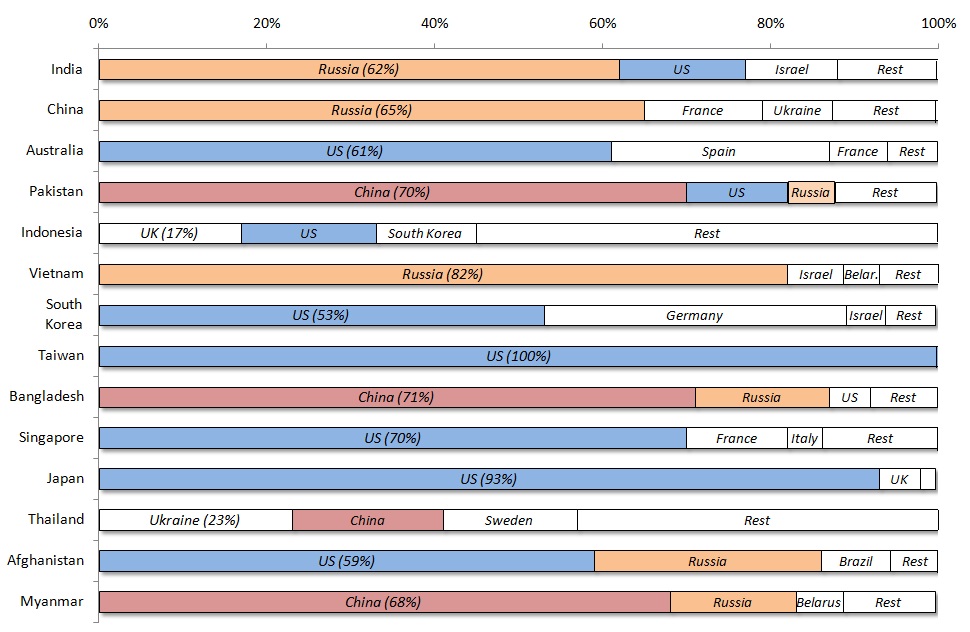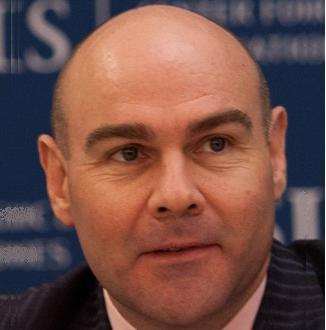![[CropImg]26169826114_aa6fb2e97e_b.jpg](/d/file/201806/f06eadc4be5b23f0105a937300952001.jpg)
At the Shangri-La Summit, U.S. Defense Secretary James Mattis accused China of "intimidation and coercion" in the Indo-Pacific. "Make no mistake: America is in the Indo-Pacific to stay. This is our priority theater," he said. What Mattis left unsaid was why America wants to stay in Asia and how U.S. defense contractors hope to turn the region into a weaponized cash cow.
What the Shangri-La Summit illustrated are the new economic and strategic realities in Asia, as reflected by vital, longstanding shifts in regional arms transfers. While the U.S. defense system remains the most innovative in the world, U.S. global military leadership continues to erode. This is particularly clear in Asia where China increasingly accounts for investment and jobs in many economies, which tends to support regional stability, while the U.S. no longer does. Instead, and as a result, America’s role relies less on its now-waning economic dominance and increasingly on its military presence— which is legitimized on the basis of the alleged “Chinese threat”— a military presence which tends to destabilize the region.
Yet, new data indicates that even the U.S. military position in Asia is eroding, as evidenced by sales of military equipment from China, Russia and several other countries in the region.
Arms exporters pivoting to Asia
In the past five years, the largest arms exporters have been the U.S., Russia, China, and to a lesser degree, France, Germany and the UK. Together, the six account for some 80% of arms exports worldwide.
Today, the main recipient region of arms imports is Asia/Oceania, which accounts for some 42% of global imports— nearly as much as the Middle East and Europe together. In the postwar era, the U.S., along with a few NATO countries, was the primary arms supplier in Asia. Today, only two countries get their arms almost solely from the U.S.: Japan and Taiwan. Others tend to be more diversified, including Australia (61% from the U.S.) and South Korea (51%). Singapore (71%) has steadily increased its arms imports from the U.S., whereas Afghanistan (59%) is decreasing its imports from the U.S. (Figure).
Russia and China are becoming the major arms sellers in the Asia/Oceania region. China is the primary supplier to Pakistan (70%), Bangladesh (71%), and Myanmar (68%), and a secondary supplier to Thailand. While China is becoming self-sufficient militarily, it also still imports some arms, mainly from Russia.
Interestingly, India, despite its rapidly-growing strategic reliance on the U.S., currently imports most of its arms from Russia (62%) and only 15% from the United States. Vietnam is in a similar position. Despite its strategic reliance on the U.S. in South China Sea disputes, it depends almost exclusively on Russia (82%) for arms supplies. Furthermore, Russia remains a vital secondary arms seller to Bangladesh, Afghanistan, and Myanmar.
Indonesia and Thailand diversify more than their peers. The former gets arms from the U.S., the UK, and South Korea, while the latter gets them from Ukraine, China, and Sweden.
Figure: Top-14 Arms Importers in Asia and their main suppliers*
Main suppliers (share of importer’s total imports, %, 2013-17)
Importer 1st, 2nd, 3rd supplier and the rest

Source: Data from SIPRI, March 2018.
Six trends in regional arms imports
After the Second World War, the U.S. still dominated much of Asia both economically and strategically. As decolonization swept across former colonies, America purposefully exploited the vacuum. Most importantly, during the Cold War, it created the security architecture in the region, including the Southeast Asia Treaty Organization (SEATO) signed in the Philippines in the mid-50s. The stated role of the organization was to contain the Soviet Union and Communism. Hence, the U.S.-led coalition in the Korean War in the early 1950s and the massacre of almost a million alleged Communists and Chinese in Indonesia in the mid- ‘60s, to the war in Vietnam and the associated destabilization in the former Indo-China in the ‘70s.
Until the late ‘70s, when SEATO was dissolved, these moves supported reconstruction, particularly in Japan and South Korea. Concern over “Communist expansion” (read: Mao’s China) translated to U.S. support for economic expansion in two former British colonies, Hong Kong and Singapore. They favored a U.S. military presence and associated economic spillovers. As these four “newly-industrialized” Asian tigers got back on their feet, they began to offshore productive capacity (and associated U.S. strategic power) in emerging Southeast Asia.
However, today the region looks very different. America’s economic role is gradually decreasing, and even its military position, as reflected by U.S. arms transfers, has declined from the Cold War era. At the same time, China has matured into a major economic force in the region, particularly as economic spillovers associated with the One Road One Belt (OBOR) initiatives are spreading.
America’s position as the chief arms exporter is beginning to decline as Russia and China are offering increasingly sophisticated military technologies for a lower price. The cost factor remains a key consideration for countries that have been close U.S. partners in the past (Indonesia, Thailand). Others have been alienated by U.S. unilateralism (Pakistan, Afghanistan).
In the past five years, India has been the largest arms importer worldwide and has accounted for 12% of the global total. During this period, its imports from the U.S. have soared by more than 550%: that's one reason why the U.S. Pacific Command was renamed the U.S. “Indo-Pacific” Command. Understandably, Washington would prefer to contain China's rise by endangering Indian rather than American lives. In New Delhi, increased U.S. arms imports reflect the Modi government’s effort to diversify its sources, however. If anything, India seeks greater strategic independence. In the short-term, the interests of these two great nations are converging; in the long-term, they may diverge.
Some countries, like Australia and South Korea, rely on U.S. arms imports but have joined OBOR initiatives. Assuming positive OBOR spillovers, other economies that are similarly positioned, like Indonesia and Thailand, may be expected to diversify away from Western imports in the future.
Following the money - From IISS Shangri-La to General Dynamics
Hosted by the International Institute for Strategic Studies (IISS), the Shangri-La Dialogue has intimate ties with the British government and Western security interests. The IISS's major funders are the world’s leading military contractors (Lockheed Martin, Northrop Grumman, Raytheon, BAE Systems, ADS Group), oil giants (BP, Chevron, Shell, Statoil), and major government and private sector interests, as evidenced by the IISS’ own reports. The summit itself is sponsored largely by the IISS's military donors, as evidenced by its website.
What unites the IISS’ U.S. donors is not so much a concern over China than a concern over being left out of the rearmament party. In fiscal 2017, the U.S. sold nearly $42 billion in weapons to foreign countries. $8 billion (20% of the total) went to the Indo-Pacific region, which remained behind the Middle East. Yet, in global arms transfers, the Asia Pacific is the most lucrative region (over 40% of the world total). As U.S. defense contractors see it, they could and should double their revenues in the region.
Unsurprisingly, then, the U.S. Secretary of Defense James Mattis is pushing for U.S. arms deals worldwide, especially in Asia. After retirement from the Marine Corps, Mattis served on the Board of Directors of General Dynamics, a leading U.S. defense contractor with $31 billion in annual revenue. It is led by Phebe Novakovic, a former CIA and Department of Defense official. Last December, Novakovic said the Asia-Pacific is a growing market for U.S. defense contractors. “People spend money on defense when they’re worried, and many of our allies in Asia are justifiably worried,” she added. To win over “unsophisticated buying authorities” and discourage national efforts to build indigenous capabilities, she advocated “upgrades to their current platforms... to be able to communicate to fight together should the need arise.”
Now, the point here is not to argue — as one might on the basis of the so-called Theranos debacle, another board membership that Mattis had to resign over a scandal relating to the blood-testing startup — that there is collusion between the U.S. government, the Pentagon, leading defense contractors and U.S. allies in Asia. Rather, the risks are in the moral hazards inherent in the (far-too) intimate ties among these different players. It is precisely such risks that will always make destabilization preferable to defense contractors. What the Asia Pacific needs is peace, stability, and economic development. Left unchecked, rearmament in the region will lead to instability and will hamper economic growth, ensuring the eclipse of the Asian Century – before it has even started.
